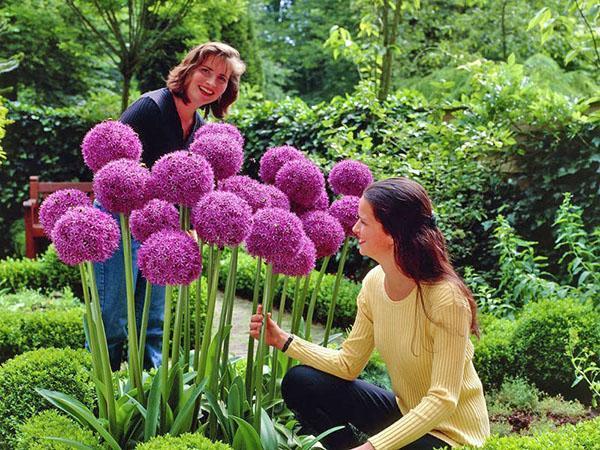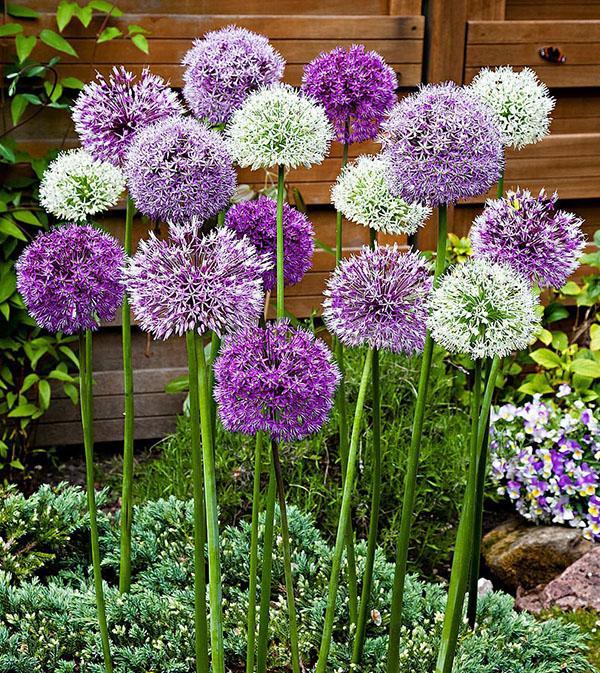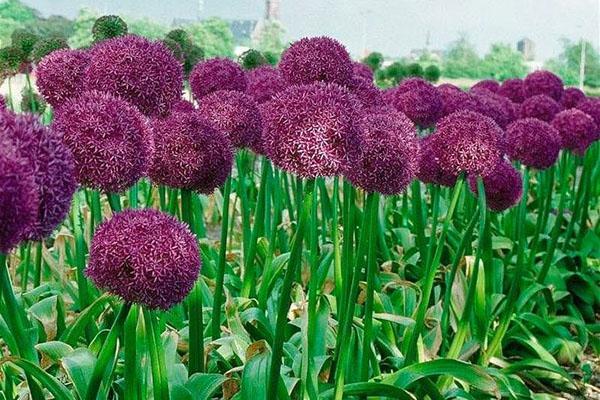Unforgettable allium: planting and caring in the open field
 Do you want to decorate your plot with unusual colors? Then pay attention to allium: planting and care in the open field is easy, and the result is impressive. The beauty of the buds, the brightness and richness of shades, the huge size of the inflorescences - all this will forever conquer your heart.
Do you want to decorate your plot with unusual colors? Then pay attention to allium: planting and care in the open field is easy, and the result is impressive. The beauty of the buds, the brightness and richness of shades, the huge size of the inflorescences - all this will forever conquer your heart.
Allium flower description

You can recognize the plant by the umbrella-shaped inflorescence in the form of a regular ball, consisting of many small flowers and located on a long swollen stem, sometimes reaching 1 m in height. Inflorescences are dense or flower-like dandelions... There are at least 400 varieties of wild onions. As for the color of the buds, they can be blue, purple, pink. Flowering occurs in late May - early June. The leaves of the plant are very narrow and long, sharp at the ends. There is also a smell characteristic of all onions and a pungent taste.
Wild onions are often used in rabatkas, rock gardens, various flower arrangements, and monocultural plantings.
How and when to plant allium in autumn
For proper development and good growth, all the nuances of planting and caring for wild onions should be observed.
Allium planting and care outdoors: basic requirements
A favorite place is open sunny areas. Moreover, the more sun, the brighter the color of the foliage. Shaded areas are unacceptable for the plant. The plant does not tolerate a large amount of moisture, so it cannot be planted in lowlands.
As for soils, then bow prefers light and fertile, and the pH level should be almost neutral. If the soil is too acidic, lime should be added to it.
Planting in open ground is best done from mid-September to late October. But this should be done at a temperature of + 10 ° C.
Pre-planting bulbs are carefully inspected for rot and mold. If they are found, the bulbs are placed in potassium permanganate and kept for half an hour.
For planting, dig holes with a depth equal to three bulbs. An onion is placed in the hole, watered well, covered with humus from above, mulching is carried out, which will protect against frost.
It is strictly forbidden to use chicken manure and manure.
Allium onion: growing and care
 Allium has no special requirements for leaving. The most important rule is not to overflow the plant, as this can lead to its death. At the same time, it is highly undesirable to allow overdrying, as this will provoke growth arrest and foliage drooping.
Allium has no special requirements for leaving. The most important rule is not to overflow the plant, as this can lead to its death. At the same time, it is highly undesirable to allow overdrying, as this will provoke growth arrest and foliage drooping.
With the arrival of spring, the plant should be fed. For this, nitrogen and potash fertilizers are used. Otherwise, the foliage will lose its brightness and become pale.
The plant requires regular weeding, as well as mulching.
The yellow foliage that forms at the end of flowering should not be torn off, as this is accompanied by the accumulation of nutrients in the bulb.
At the end of June, when the bulbs have absorbed all the necessary substances, they can be dug up and sent to a warm and dry place. They cannot be left in the ground, because they can be flooded with rain, which will lead to death.
Bulbs can only be left in the soil if you live in hot climates. But you must remember that the bulbs will give children, they will be crowded, which will lead to smaller flowers and rare flowering.
How to propagate and when to plant allium
Wild onions breed in several ways.
Vegetative with the help of children
 Three years after planting the seeds, the bulb produces babies, which must be planted very carefully in the fall so that the roots and stems are not damaged. The excavated material is stored at a temperature of 18-20 ° C in a dry and ventilated room.
Three years after planting the seeds, the bulb produces babies, which must be planted very carefully in the fall so that the roots and stems are not damaged. The excavated material is stored at a temperature of 18-20 ° C in a dry and ventilated room.
Planting early-flowering allium in the ground is recommended in autumn, and late-flowering in spring.
The bulbs are planted at a distance of half a meter from each other to a depth of three bulbs, after watering the hole, and after planting, mulching with humus or peat. Next time they can be transplanted in 4-5 years.
Vegetative with bulb
Onion buds act as bulbs, which must be pretreated with a growth stimulant and rooted. This method of reproduction fully conveys all the characteristics of the parent variety to the future plant.
Seed method
Treated seeds are usually sown in the fall or spring directly into the ground. Some varieties require prior stratification. This method is very long, since the plant will open its buds only after three years. Therefore, it is not popular.
Diseases and pests
 During planting and caring for an allium, the plant can be exposed to such pests:
During planting and caring for an allium, the plant can be exposed to such pests:
- Tobacco thrips that feed on plant sap and buds. This leads to the fact that the plant becomes weak, ceases to participate in photosynthesis. You can eliminate the pest by spraying and root irrigation with insecticidal agents. For example, it can be: "Spintor", "Mospilan", "Vertimek", "Aktara". But to prevent the occurrence of an insect, high humidity should be created at the landing site.
- Neck rot affects the bulbs if stored improperly. In order to prevent its occurrence, the bulbs need to be dug up and dried in the sun, and then heated at 48 ° C for 12 hours.
- Onion fly. The symptoms of the disease are early yellowing of the foliage, rotting of the bulb and its subsequent death. You can protect the bulb by planting it early in the ground. If the disease has developed, you can use a salt solution or drugs such as "Ratibor", "Medvetoks-U", "Karate".
- Downy mildew. Its appearance can be prevented by subjecting the bulbs to heating at 40-42 ° C for 12 hours before planting.
As you can see, planting and caring for an allium outdoors is not difficult at all. Subject to all the rules, the plant will delight you with lush flowering: huge multi-colored balls.